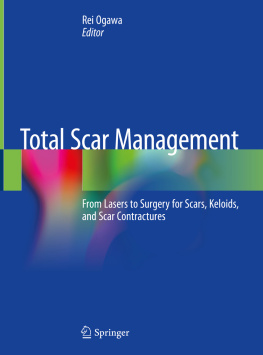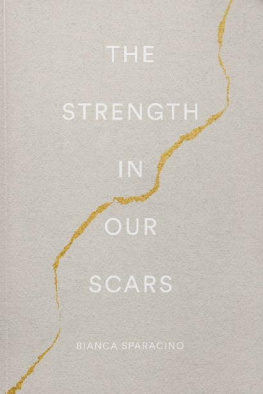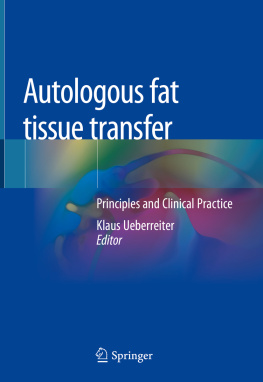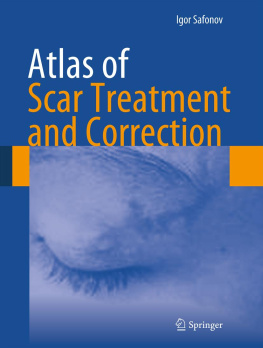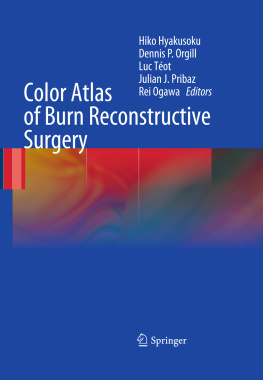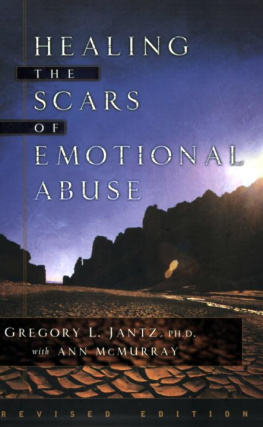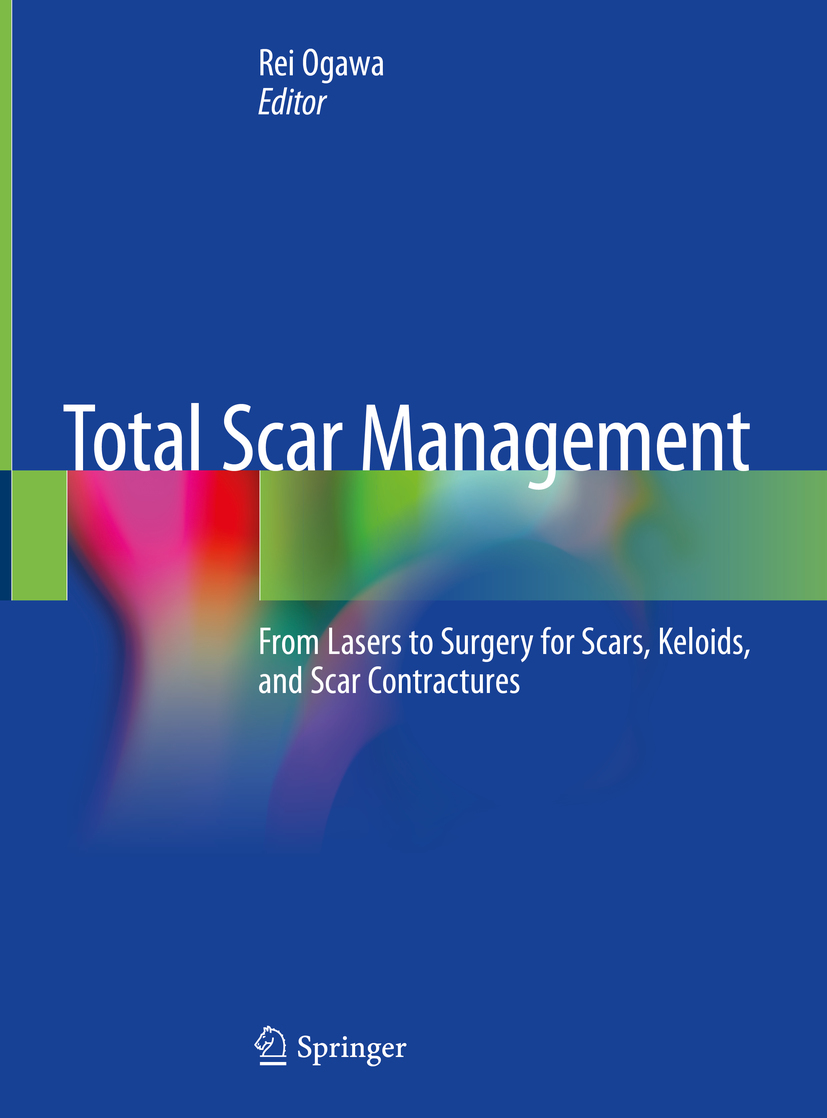Total Scar Management
From Lasers to Surgery for Scars, Keloids, and Scar Contractures
Editor
Rei Ogawa
Department of Plastic, Reconstructive and Aesthetic Surgery, Nippon Medical School, Tokyo, Japan
ISBN 978-981-32-9790-6 e-ISBN 978-981-32-9791-3
https://doi.org/10.1007/978-981-32-9791-3
Springer Nature Singapore Pte Ltd. 2020
This work is subject to copyright. All rights are reserved by the Publisher, whether the whole or part of the material is concerned, specifically the rights of translation, reprinting, reuse of illustrations, recitation, broadcasting, reproduction on microfilms or in any other physical way, and transmission or information storage and retrieval, electronic adaptation, computer software, or by similar or dissimilar methodology now known or hereafter developed.
The use of general descriptive names, registered names, trademarks, service marks, etc. in this publication does not imply, even in the absence of a specific statement, that such names are exempt from the relevant protective laws and regulations and therefore free for general use.
The publisher, the authors, and the editors are safe to assume that the advice and information in this book are believed to be true and accurate at the date of publication. Neither the publisher nor the authors or the editors give a warranty, expressed or implied, with respect to the material contained herein or for any errors or omissions that may have been made. The publisher remains neutral with regard to jurisdictional claims in published maps and institutional affiliations.
This Springer imprint is published by the registered company Springer Nature Singapore Pte Ltd.
The registered company address is: 152 Beach Road, #21-01/04 Gateway East, Singapore 189721, Singapore
Contents
Part IBasic Science of Scars
Adriana C. Panayi , Chanan Reitblat and Dennis P. Orgill
Haig A. Yenikomshian and Nicole S. Gibran
Antoinette T. Nguyen , Jie Ding and Edward E. Tredget
Chao-Kai Hsu , Hsing-San Yang and John A. McGrath
Rei Ogawa
Part IIClinical Plactice of Scars
Satoko Yamawaki
Chenyu Huang , Longwei Liu , Zhifeng You , Zhaozhao Wu , Yanan Du and Rei Ogawa
Mi Ryung Roh and Kee Yang Chung
Mark Fisher
J. Genevieve Park and Joseph A. Molnar
Rei Ogawa
Ioannis Goutos
Yaron Har-Shai and Lior Har-Shai
Timothy A. Durso , Nathanial R. Miletta , Bart O. Iddins and Matthias B. Donelan
1. Wound Healing and Scarring
1.1 Introduction
From the dawn of man to the present day, traumatic injuries have persisted as a major cause of morbidity and mortality. Even as recently as the Civil War in the United States, up to 24% of upper extremity amputations and 88% of amputations just below the hip resulted in death []. Increased insight into the cellular and molecular mechanisms underpinning wound healing holds promise for improving the lives of these individuals and driving the development of new therapies. Accordingly, in this chapter we will focus attention on understanding the mammalian response to injury, basic mechanisms of healing, local and systemic factors affecting healing, and recent advances in the management of chronic wounds and scars.
1.2 Mammalian Response to Injury
Healing is not a science, but the intuitive art of wooing natureW.H. Auden []
1.2.1 Basic Concepts in Homeostasis, Growth Adaptation, and Injury
The survival of a living organism depends on its ability to maintain a stable internal environment, known as homeostasis. When homeostasis is perturbed by environmental changes, also known as stressors, complex biological systems within the organism work in tandem to reestablish equilibrium via the process of growth adaptation [].
As a homeostatic regulatory response, growth adaptation depends on the type of stressor, its magnitude, and the type of cell, tissue, or organ affected. Take, for example, the response of skeletal muscle to mechanical stress in the form of strength training. As the mechanical stress increases, muscle cells respond in kind by increasing the number of contractile proteins, myofibrils, and energy stores leading to an overall growth in cell size known as hypertrophy []. The response to increased stress need not be binary, however, as seen in the gravid uterus which undergoes both hypertrophy and hyperplasia in response to mechanical and hormonal stimuli in order to better accommodate a growing fetus.
In contrast to the above processes, tissues experiencing a decrease in stress diminish in size, or atrophy, due to disuse or withdrawal of trophic factors such as oxygen, nutrients, and hormonal stimulation. Mechanisms of atrophy include a decrease in cell size or number. The former occurs via autophagy (Ancient Greek for self-eating), in which cytoplasmic contents are enzymatically degraded and recycled within lysosomes, as well as the ubiquitin-proteosome pathway which targets short-lived (and often damaged) proteins for destruction []. A decrease in cell number, on the other hand, can be achieved by an organized program of cell death known as apoptosis or the chaotic destruction of large groups of cells in response to injury as seen in necrosis.
External changes in mechanical stress can lead to changes in cell size or number, while certain environmental exposures can induce metaplasia, a reversible transformation of one differentiated cell type into another type better suited to handle this exposure. The most common forms of metaplasia involve changes in surface epithelium. A classic example is the alteration in the lining of the lower esophagus in the setting of persistent reflux esophagitis, known as Barretts esophagus. The typical lining of the esophagus is squamous epithelium which can slough off without damaging underlying layers and is, therefore, ideal for overcoming the mechanical friction of a food bolus. When there is chronic inflammation due to persistent acid reflux, however, epithelial stem cells are reprogrammed into mucus-secreting columnar cells like those seen in the small intestine which are better able to withstand an acidic environment. Although this may be beneficial in the short term, this process of cellular reprogramming can be maladaptive if the inciting exposure is not resolved. With time, cellular growth and proliferation becomes disordered, known as

